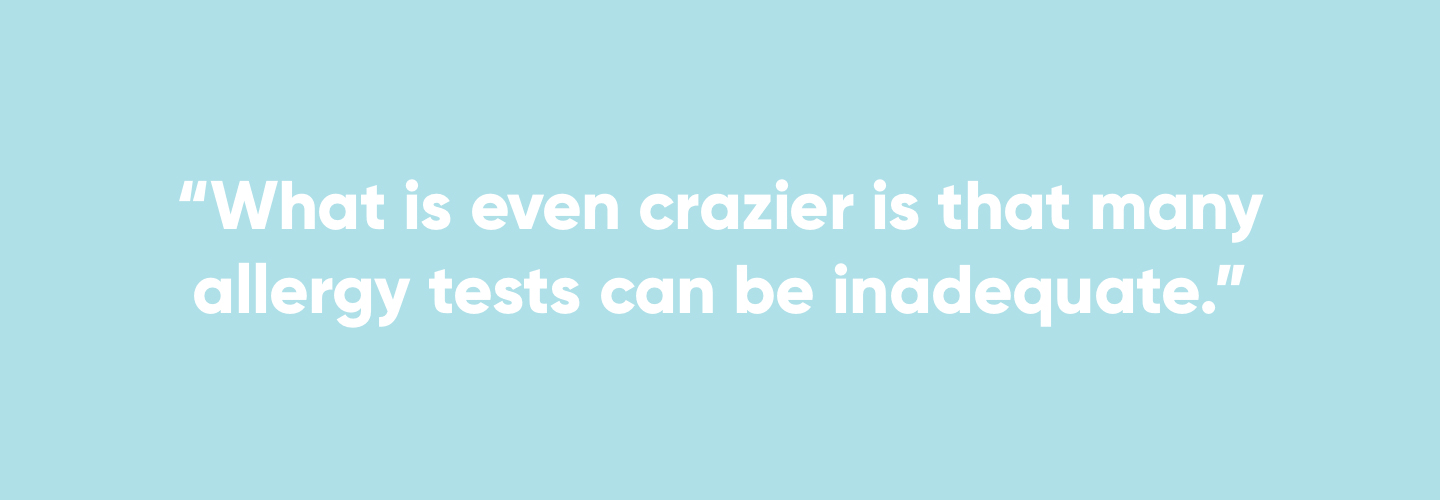According to one study, 12%-18% of the population say they have a food allergy or food intolerance, but it’s estimated that approximately 10% of the population has been diagnosed with food allergies or food intolerances.1 It’s possible this inconsistency is happening because of an increase in perceived health risks of certain foods but also because pseudo-allergies or food intolerances can cause the same symptoms as allergies!1
What many might not know is that both allergies and pseudo-allergies cause hives, gastrointestinal problems, asthma, circulatory fractions, and even allergic shock or atopic eczema! What is even crazier is that many allergy tests can be inadequate. Numerous commercial laboratories, for example, are equipped with allergy tests that are designed to detect over 200 foods in a single run.2 According to Sethi, T.J. et al 1987, these tests are not sufficient for a diagnosis because they indicate both false-positive and false-negative results.3 For example, one laboratory found a milk allergy in 70% of symptom-free subjects by hair analysis!
Testing: What is a reliable diagnosis?

Consult a family physician before starting your child on a special diet. The physician should conduct a provocation test (a clinical trial). If the symptoms subside after the suspicious trigger (food type) is omitted and reappear after controlled administration, the diagnosis is justified. Nontargeted elimination diets or avoidance recommendations due to nonreproducible test procedures should be avoided: They represent an unjustified lifestyle change and could lead to malnutrition.
Prevention: Is prevention possible?
Prevention hasn’t been proven, but there are great studies out there that share ways to decrease the likelihood of your child developing a food allergy, including:
- Breastfeeding (as long as it suits you and your child):
Studies have shown that breastfeeding may have benefits when it comes to helping prevent food allergies. There also are studies that indicate introducing solid foods to infants aged between 4 and 6 months could be beneficial. The best route isn’t clear, so it’s definitely a good idea to have a conversation with your pediatrician, who can connect the dots between you and your baby’s specific situation and the latest research.
- Trust your child:
If your baby doesn’t want to eat solid foods, don’t worry — he or she doesn’t need to eat a lot of solid food to prevent allergies. In fact, it’s enough if they suck on a piece of food and only very tiny amounts of it end up in baby’s tummy. There are advantages to this: Your baby’s digestive system can get used to solid foods if you introduce them slowly. However, don’t force or trick your baby into eating something they don’t want to eat. That could damage their instincts on what is good for them. Trust your baby!4
Allow your baby to gobble up anything he or she is ready to eat — you will know when a doctor’s opinion is needed!
Sources:
1 Wüthrich, B. 1996. Zur Nahrungsmittelallergie: Begriffsbestimmung, Diagnostik, Epidemiologie, Klinik. Schweiz Med Wochenschr. 126(18): 770-776.
2 Gall, H., and W. Sterry. 1994. Food allergy: clinical aspects, diagnosis and therapy from the dermatologic viewpoint. Dtsch Med Wochenschr. 119(21): 773-777.
3 Sethi, T.J., D.M. Kemeny, S. Tobin, M.H. Lessof, and A. Bradley. 1987. How reliable are commercial allergy tests? Lancet. 329(8524): 92-94.
4 Davis, C.M. 1939. Results of the self-selection of diets by young children. Can Med Assoc J. 41(3): 257-261.

